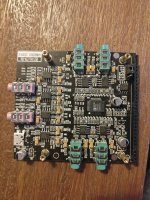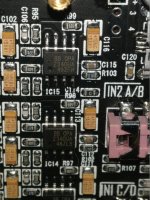Hi,
Sorry my ignorant question. Not very technical here.
I have a DSP that has a sensitivity of 0.9vRMS single ended. Right now I am using an amplifier that requieres 1.2vRMS for full power, so not a problem.
I will upgrade to an amplifier that needs balanced or SE input, but has a sensitivity on 2vRMS.
My idea is to use a converter or preamplifer between the DSP's output and the amplifier's input.
Do I need a SE to balanced converter like THIS which offer a 2x / 6dB gain.
Or I can get away with a preamp like THIS
I know this opamp are probably fake, but let's suppose they are the real deal (I can eventually buy some OPA1656 from Mouser).
This is a 16 channel DSP so I kind of need a "cheap" solution.
Thanks in advance
Sorry my ignorant question. Not very technical here.
I have a DSP that has a sensitivity of 0.9vRMS single ended. Right now I am using an amplifier that requieres 1.2vRMS for full power, so not a problem.
I will upgrade to an amplifier that needs balanced or SE input, but has a sensitivity on 2vRMS.
My idea is to use a converter or preamplifer between the DSP's output and the amplifier's input.
Do I need a SE to balanced converter like THIS which offer a 2x / 6dB gain.
Or I can get away with a preamp like THIS
I know this opamp are probably fake, but let's suppose they are the real deal (I can eventually buy some OPA1656 from Mouser).
This is a 16 channel DSP so I kind of need a "cheap" solution.
Thanks in advance
Last edited:
You are between a rock and a hard place, in any case you will need to do some soldering, replace TINY parts, etc.
Plus nobody has the original schematics.
I would plain build a stereo (or as many channels as you need) using a dual Op Amp and some perfboard, you can set it to any gain you wish, inverting ornot, balanced or unbalanced out.
But you´ll need to read a schematic, solder, and somehow house and feed it.
Plus nobody has the original schematics.
I would plain build a stereo (or as many channels as you need) using a dual Op Amp and some perfboard, you can set it to any gain you wish, inverting ornot, balanced or unbalanced out.
But you´ll need to read a schematic, solder, and somehow house and feed it.
With the cheap converters, clocking, etc., in a low-cost DSP, a little noise seems likely not the worst of audible problems. Clipping would be another matter.
A buffer with gain could always be added between the DSP analog output and an power amp input. IMHO clean power, clean implementation, and quality components would normally help, but my guess would be that thecheap low-cost DSP will dominate what can be achieved.
A buffer with gain could always be added between the DSP analog output and an power amp input. IMHO clean power, clean implementation, and quality components would normally help, but my guess would be that the
Last edited:
I know implementation is king, but the ADAU1452 even thou low cost, is quite powerful by modern DSP's standards, much more powerful than any DSP integrated in active speakers under USD$300ish... so packing it with a good amplifier (one better than the ones integrated on the same powered speakers mentioned above) and you have a nice and cheap active speaker.
Of course, going the HypeX Fusionamp route would be ideal, but with this setup the cost would be more than 3 times less... and maybe for 80% of the SQ.
Right now, my amps are Anaview/Abletec ALC100-2300 which work OK with the 1.0vRMS sensitivity of the DSP, but I thought upgrading the amps and going the TPA3255 way (3e or drMordor) and I will certainly need more 2vRMS and better yet balanced.
Of course, going the HypeX Fusionamp route would be ideal, but with this setup the cost would be more than 3 times less... and maybe for 80% of the SQ.
Right now, my amps are Anaview/Abletec ALC100-2300 which work OK with the 1.0vRMS sensitivity of the DSP, but I thought upgrading the amps and going the TPA3255 way (3e or drMordor) and I will certainly need more 2vRMS and better yet balanced.
I think too many obsess over the input sensitivity. It's just a number. Specifically, it's the voltage required to drive the amp to clipping (or to some specified output power). It doesn't mean that your source has to provide that voltage.
If you are concerned about gain structure (and I do think that's a good concern to have), connect your current 0.9 V DSP to the amp with 2 V input sensitivity. Crank the volume control. Only add gain if you can't get the music loud enough for your liking.
If you would like to add gain (and/or use the balanced inputs on the new amp) something like the Neurochrome Universal Buffer would work well for you. You can configure it for gain by adding a through-hole resistor.
Alternatively, you need to change some of the resistors in the output stage of your DSP. If you have a schematic (and the skills to solder SMD parts), we can help you find suitable values. Just swapping the opamp won't change the gain. The gain is set by the ratio between two (or more) resistors and is (practically) independent of the opamp.
Tom
If you are concerned about gain structure (and I do think that's a good concern to have), connect your current 0.9 V DSP to the amp with 2 V input sensitivity. Crank the volume control. Only add gain if you can't get the music loud enough for your liking.
If you would like to add gain (and/or use the balanced inputs on the new amp) something like the Neurochrome Universal Buffer would work well for you. You can configure it for gain by adding a through-hole resistor.
Alternatively, you need to change some of the resistors in the output stage of your DSP. If you have a schematic (and the skills to solder SMD parts), we can help you find suitable values. Just swapping the opamp won't change the gain. The gain is set by the ratio between two (or more) resistors and is (practically) independent of the opamp.
Tom
The idea is having the correct gain structure and avoid clipping and noise.
And you feel that an output of 1V and input sensitivity of 2V is not that?
It's just a notch on the volume control.
Are you really going through a lot of new parts and stuff without being sure you really need it? What will that do to your sound quality?
The intelligent thing to do is what tomchr said: just try it, and report back if you really, really can't blow out the windows as you were planning.
Jan
If you would like to add gain (and/or use the balanced inputs on the new amp) something like the Neurochrome Universal Buffer would work well for you. You can configure it for gain by adding a through-hole resistor.
The DSP has 8 output channels. It might get pricey if this is a multi-amp setup.
Alternatively, you need to change some of the resistors in the output stage of your DSP.
The outputs are unity gain filters. There are no resistors to change . They would have to be added. The schematic is attached to the seventh post.
Last edited:
I think too many obsess over the input sensitivity. It's just a number. Specifically, it's the voltage required to drive the amp to clipping (or to some specified output power). It doesn't mean that your source has to provide that voltage.
If you are concerned about gain structure (and I do think that's a good concern to have), connect your current 0.9 V DSP to the amp with 2 V input sensitivity. Crank the volume control. Only add gain if you can't get the music loud enough for your liking.
If you would like to add gain (and/or use the balanced inputs on the new amp) something like the Neurochrome Universal Buffer would work well for you. You can configure it for gain by adding a through-hole resistor.
Alternatively, you need to change some of the resistors in the output stage of your DSP. If you have a schematic (and the skills to solder SMD parts), we can help you find suitable values. Just swapping the opamp won't change the gain. The gain is set by the ratio between two (or more) resistors and is (practically) independent of the opamp.
Tom
I don't know or I am not sure, that's why I ask... so, do you think it's not a problem then?
The problem is not ADAU1452. The problems are the quality of the A/D and D/A converters, the analog circuitry power supplies, clock jitter for the data converters, etc.
The A/D and D/A are managed with the AD1938 which spec wise is not THAT bad. Not expecting ESS SABRE or AKM performance here, just around medium priced active speaker performance.
And you feel that an output of 1V and input sensitivity of 2V is not that?
It's just a notch on the volume control.
Are you really going through a lot of new parts and stuff without being sure you really need it? What will that do to your sound quality?
The intelligent thing to do is what tomchr said: just try it, and report back if you really, really can't blow out the windows as you were planning.
Jan
OK. this seems the way to go then... just try it and see how it works... At least it's not a blatant "It will not work!". So, I think I will just try it and report.
I don't know or I am not sure, that's why I ask... so, do you think it's not a problem then?
Like I said earlier: It's only an issue if you can't get to the desired loudness level when you crank the volume control to the max.
As Jan said: Try it.
Tom
- Home
- Source & Line
- Digital Line Level
- Does OPAMP offer gain?

